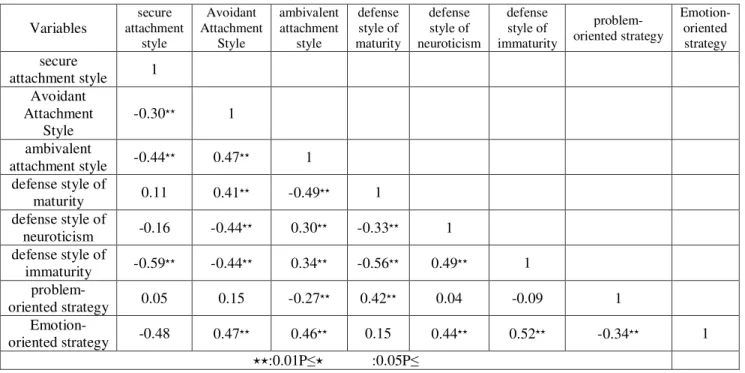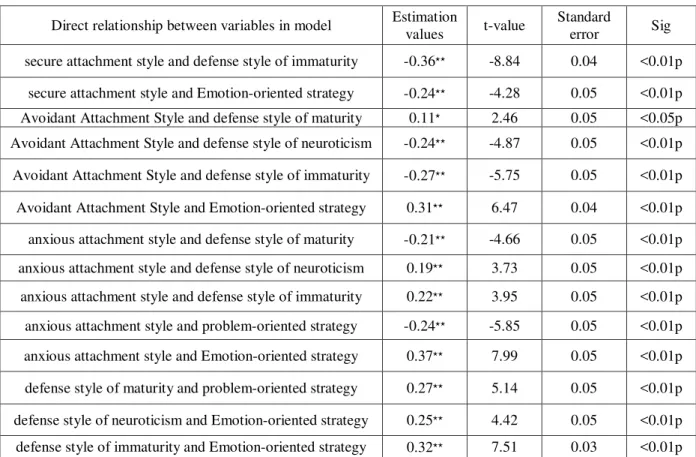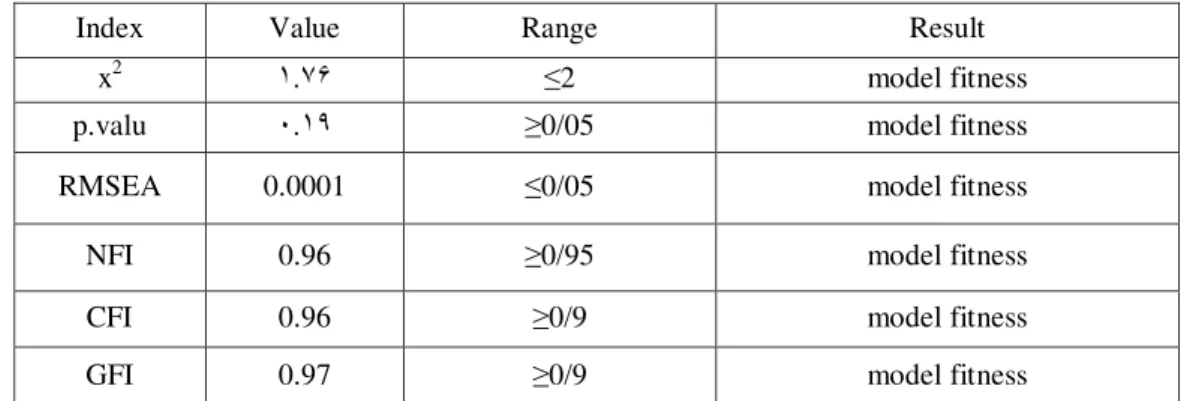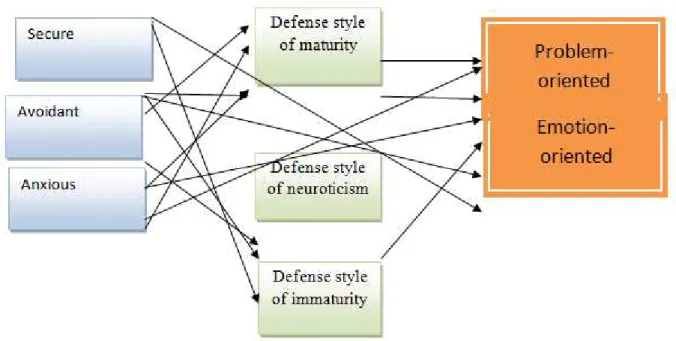http://www.bipublication.com
Research Article
The structural relationship between attachment styles and coping strategies
with mediation of defense mechanisms in mothers of children with cancer
Nasrin Zabihi and Farhad Jomehri
Islamic Azad University of Iran, Kish International Unit
ABSTRACT
The main objective of the present research is to determine the structural relationship between attachment styles and coping strategies with mediation of defense mechanisms. Descriptive correlation has been considered as the research method. The statistical population consists of all the mothers of the children with cancer who have referred to the hospitals and cancer clinics during 2014-2015. The samples over 200 parents were selected via convenient sampling. To collect field data, questionnaires of attachment style, coping strategies and defense mechanisms have been used. Data analysis was made using software SPSS and Lisrel. With regard to the results from the present research, there is a significant structural relationship between attachment styles and coping strategies with mediation of defensive mechanisms in mothers of children with cancer.
Key words- attachment styles, coping strategies, defensive mechanisms
INTRODUCTION
Cancer has been considered as one of the major causes of mortality worldwide, so that new epidemic at our age has been recognized after heart diseases. Cancer is the third leading cause of death in Iran after heart diseases, accidents and other natural phenomena (Khanjari et al. 2013) and is the second cause of death for children in third world countries (Kaatsch, 2010). Childhood cancer is a fatal disease that is followed by stress, emotional stability, fear, depression, lifestyle changes and uncertainty about the future. Children and adolescents with cancer are subjected to high risk for depression and other mental disorders due to the disease and its treatment (Matziou et al., 2008). On the other hand, treatment of cancer at childhood is an experience with high levels of stress, challenging and disturbing for children and their family members (Ries et al. 2005). The family system is an important factor to children with a chronic disease (Kazak et al., 2003). Children’s coping with a stressor such as cancer can be influenced by the people around them and the
conduct emotional reactions in individuals and inter-personal relationships. John Bowlby has put emphasis on importance of maternal behavior style and its effect on child attachment. Bowlby in an emphasis on the importance of mother-child communication believes that many forms of mental and personality disorders result from the child’s deprivation from maternal care and/or instability of the child’s relationship with attachment face. At the end of childhood and early adolescence, mother has been considered as the main attachment face and children refuge mother in the face of stress and anxiety. Mother’s failure to create a warm, sensitive and responsive relationship in the first year of life raises stable mood and behavioral problems in child. Any gap in mother-child communication can have decisive negative impact on the development of children's personality and mental health (Jahan bakhsh, Bahaduri, Amiri and Anisi, 2012). The parent-child relationship might be the most important predictor of interpersonal communication in adulthood and how to adapt with critical situations (Akhtar, 2012). This interaction is a mental model of "self” in relation to others (Tamaki & Takahashi, 2013). Nayebi nia(2011), Shahabi zadeh & dastjerdi (2011) in their study obtained these results that stress and anxiety have a negative correlation with parents’ secure
attachment style. When the child is suffering from cancer, women are affected by this incident. When a child is diagnosed with a fatal disease, mother is severely distraught and basically every mother may be affected by this issue in a certain form and react to it in different ways. Therefore, the main questions is what a structural relationship exists between attachment styles and coping strategies with mediation of defense mechanisms in mothers of children with cancer?
Research method
In the present research, data were analyzed using software SPSS and Lisrel. In this regards, descriptive data including mean, standard deviation, Skewness and Kurtosis were analyzed via software SPSS. Structural equation modeling via software Lisrel was used to examine structural relationship between research variables.
Findings
Correlation matrix of the research variables has been represented in table 1. In this table, 3 variables under study were examined on individuals in sample group. This table requires for examining model. Sarmad et al.(2008) stated that correlation matrix of existing variables which are calculated in model are used as the early data of structural equation modeling and path analysis.
Table 1. Correlation matrix of research variables
Variables
secure attachment
style
Avoidant Attachment
Style
ambivalent attachment
style
defense style of maturity
defense style of neuroticism
defense style of immaturity
problem-oriented strategy
Emotion-oriented strategy secure
attachment style 1 Avoidant
Attachment Style
⋆⋆ 0.30
- 1
ambivalent
attachment style -0.44⋆⋆ 0.47 ⋆⋆ 1 defense style of
maturity 0.11 0.41 ⋆⋆ -0.49⋆⋆ 1 defense style of
neuroticism -0.16 -0.44⋆⋆ 0.30 ⋆⋆ -0.33⋆⋆ 1 defense style of
immaturity -0.59⋆⋆ -0.44⋆⋆ 0.34 ⋆⋆ -0.56⋆⋆ 0.49 ⋆⋆ 1
problem-oriented strategy 0.05 0.15 -0.27⋆⋆ 0.42 ⋆⋆ 0.04 -0.09 1
Table 1 represents correlation between all the variables with each other. With regard to the results shown in table above, the highest correlation coefficient relates to defense style of maturity and Emotion-oriented strategy, and secure attachment style and defense style of immaturity. Insignificant correlations include the relationship between secure attachment style and defense style of maturity, defense style of neuroticism and problem-oriented strategy. Further, there is not a significant relationship between Avoidant Attachment Style and problem-oriented strategy. There is not a significant relationship between defense style of neuroticism, defense style of immaturity and problem-oriented strategy.
Path analysis of the model variables representing the relationship between attachment styles, defense mechanisms and coping strategy
Software Lisrel and structural equation modeling were used to examine variables of model representing attachment styles, defense mechanisms and coping strategy which includes exogenous variable of attachment styles and mediator defense mechanism. Direct and indirect effects have been represented in next tables.
Direct effects
Table 2. Coefficients of direct effects
Sig Standard error t-value Estimation values Direct relationship between variables in model
0.01 < p 0.04 8.84 -⋆⋆ 0.36 -secure attachment style and defense style of immaturity
0.01 < p 0.05 4.28 -⋆⋆ 0.24 -secure attachment style and Emotion-oriented strategy
0.05 < p 0.05 2.46 ⋆ 0.11 Avoidant Attachment Style and defense style of maturity
0.01 < p 0.05 4.87 -⋆⋆ 0.24 -Avoidant Attachment Style and defense style of neuroticism
0.01 < p 0.05 5.75 -⋆⋆ 0.27 -Avoidant Attachment Style and defense style of immaturity
0.01 < p 0.04 6.47 ⋆⋆ 0.31 Avoidant Attachment Style and Emotion-oriented strategy
0.01 < p 0.05 4.66 -⋆⋆ 0.21 -anxious attachment style and defense style of maturity
0.01 < p 0.05 3.73 ⋆⋆ 0.19 anxious attachment style and defense style of neuroticism
0.01 < p 0.05 3.95 ⋆⋆ 0.22 anxious attachment style and defense style of immaturity
0.01 < p 0.05 5.85 -⋆⋆ 0.24 -anxious attachment style and problem-oriented strategy
0.01 < p 0.05 7.99 ⋆⋆ 0.37 anxious attachment style and Emotion-oriented strategy
0.01 < p 0.05 5.14 ⋆⋆ 0.27 defense style of maturity and problem-oriented strategy
0.01 < p 0.05 4.42 ⋆⋆ 0.25 defense style of neuroticism and Emotion-oriented strategy
0.01 < p 0.03 7.51 ⋆⋆ 0.32 defense style of immaturity and Emotion-oriented strategy
It should be noted that significant results have been represented in table above due to facilitated understanding of obtained findings. With regard to table above, direct effect of secure attachment style on defense style of immaturity and Emotion-oriented strategy is significant at P≤0.01. Direct effect of avoidant attachment style on defense style of maturity, defense style of neuroticism and defense style of immaturity is significant at P≤0.01. Direct effect of avoidant attachment style on Emotion-oriented strategy is significant at P≤0.01. Direct effect of anxious attachment style on defense style of maturity, defense style of neuroticism and defense style of immaturity is significant at P≤0.01. Direct effect of anxious attachment style on problem-oriented strategy and Emotion-oriented strategy is significant at
P≤0.01. Direct effect of defense style of maturity on problem-oriented strategy is significant at P≤0.01.
Indirect effects
Further, the values in direct relationship between independent variables and coping strategies in the model can be observed in table below.
Table 3. Estimation of coefficients of indirect effect
Sig Standard
error t-value
Standardized parameter indirect relationship between independent
variables
0.05 < p 0.04
3.56 ⋆
0.09 Effect of secure attachment style on
Emotion-oriented strategy with mediation of defense mechanisms
0.05 < p 0.05
2.97 -⋆
0.06 -Effect of Avoidant Attachment Style on Emotion-oriented strategy with mediation of defense style of neuroticism
0.05 < p 0.04
3.67 -⋆⋆
0.09 -Effect of Avoidant Attachment Style on Emotion-oriented strategy with mediation of defense style of immaturity
0.05 < p 0.05
2.89 -⋆⋆
0.06 -Effect of anxious attachment style on problem-oriented strategy with mediation of defense style of maturity
0.05p 0.12
1.73 ⋆⋆
0.05 Effect of anxious attachment style on
Emotion-oriented strategy with mediation of defense style of neuroticism
0.05 < p 0.04
3.04 ⋆⋆
0.07 Effect of anxious attachment style on
Emotion-oriented strategy with mediation of defense style of immaturity
With regard to what represented in table above, indirect effect of secure attachment style on Emotion-oriented strategy with mediation of defense style of immaturity is significant at P≤0.05.
Indirect effect of Avoidant Attachment Style on Emotion-oriented strategy with mediation of defense style of neuroticism is significant at P≤0.05.
Indirect effect of Avoidant Attachment Style on Emotion-oriented strategy with mediation of defense style of immaturity is significant at P≤0.05.
Indirect effect of anxious attachment style on problem-oriented strategy with mediation of defense style of maturity is significant at P≤0.05.
Indirect effect of anxious attachment style on problem-oriented strategy with mediation of defense style of maturity is not significant at P≤0.05.
Indirect Effect of anxious attachment style on Emotion-oriented strategy with mediation of defense style of immaturity is significant at P≤0.05.
Major hypothesis
Features of model fitness
The values related to indices of model fitness have been represented in table below:
Table 4. Indices of model fitness
Index Value Range Result
x2 ١.٧۶ ≤2 model fitness
p.valu ٠.١٩ ≥0/05 model fitness
RMSEA 0.0001 ≤0/05 model fitness
NFI 0.96 ≥0/95 model fitness
CFI 0.96 ≥0/9 model fitness
GFI 0.97 ≥0/9 model fitness
which is under criterion value (0.05), thus it can conclude that model enjoys fitness. Obtained NFI in table equals to 0.96 which is greater than 0.95, indicating suitable fitness. CFI index equals to 0.96 which is greater than 0.9, indicating suitable fitness. The obtained GFI equals to 0.97 which is greater than 0.9, indicating suitable fitness. In general, the indices relating to model fitness indicate suitable model fitness.
The model representing the relationship between attachment styles and coping strategies with mediation of defense mechanisms. Ultimately, the model extracted from research is as follow:
Figure 1. Final path of model
With regard to the obtained results, the obtained model concerning the relationship between attachment styles and coping strategies with mediation of defense mechanisms is significant. Secondary hypotheses
-Defensive mechanisms have a direct effect on problem-oriented strategy and Emotion-oriented strategy in mothers of children with cancer. Direct effect of defense style of maturity on problem-oriented strategy is significant at P≤0.01.
Direct effect of defense style of neuroticism on Emotion -oriented strategy is significant at P≤0.01.
Direct effect of defense style of immaturity on Emotion -oriented strategy is significant at P≤0.01.
-Secure attachment style has a direct effect on problem-oriented strategy and Emotion-oriented strategy in mothers of children with cancer. Direct effect of secure attachment style on problem-oriented strategy is significant at P≤0.01.
Direct effect of secure attachment style on Emotion -oriented strategy is significant at P≤0.01.
Direct effect of secure attachment style on Emotion -oriented strategy is not significant at P≤0.05.
-Avoidant attachment style has a direct effect on problem-oriented strategy and Emotion-oriented strategy in mothers of children with cancer. Direct effect of Avoidant attachment style on problem-oriented strategy is significant at P≤0.01.
Direct effect of Avoidant attachment style on Emotion -oriented strategy is not significant at P≤0.01.
Direct effect of anxious attachment style on Emotion -oriented strategy is not significant at P≤0.01.
-Secure attachment style has a direct effect on defense mechanisms in mothers of children with cancer.
Direct effect of secure attachment style on defense style of immaturity is significant at P≤0.01.
Direct effect of secure attachment style on defense style of neuroticism and defense style of maturity is not significant at P≤0.01.
-Avoidant attachment style has a direct effect on defense mechanisms in mothers of children with cancer.
Direct effect of Avoidant attachment style on defense style of maturity is significant at P≤0.01.
Direct effect of Avoidant attachment style on defense style of neuroticism is significant at P≤0.01.
Direct effect of Avoidant attachment style on defense style of maturity is significant at P≤0.01.
-anxious attachment style has a direct effect on defense mechanisms in mothers of children with cancer.
Direct effect of anxious attachment style on defense style of maturity is significant at P≤0.01.
Direct effect of anxious attachment style on defense style of neuroticism is not significant at P≤0.01.
Direct effect of anxious attachment style on defense style of maturity is significant at P≤0.01.
-Secure attachment style has an indirect effect on problemoriented strategy and Emotion -oriented strategy in mothers of children with cancer.
Indirect effect of secure attachment style on emotion-oriented strategy with mediation of defense style of immaturity is significant at P≤0.05.
Indirect effect of secure attachment style on problem-oriented strategy with mediation of defense style of immaturity is significant at P≤0.05.
-Avoidant attachment style has an indirect effect on problemoriented strategy and Emotion -oriented strategy in mothers of children with cancer.
Indirect effect of Avoidant attachment style on emotion-oriented strategy with mediation of defense style of neuroticism is significant at P≤0.05.
Indirect effect of Avoidant attachment style on emotion-oriented strategy with mediation of defense style of immaturity is significant at P≤0.05.
Indirect effect of Avoidant attachment style on problem-oriented strategy with mediation of defense mechanisms is not significant at P≤0.05. -anxious attachment style has an indirect effect on problemoriented strategy and Emotion -oriented strategy in mothers of children with cancer.
Indirect effect of anxious attachment style on emotion-oriented strategy with mediation of defense style of neuroticism is significant at P≤0.05.
Indirect effect of anxious attachment style on emotion-oriented strategy with mediation of defense style of immaturity is significant at P≤0.05.
Indirect effect of anxious attachment style on problem-oriented strategy with mediation of defense mechanisms is not significant at P≤0.05.
DISCUSSION AND CONCLUSION
attachment style of adolescents with cancer. Mohebi(2013) in a research aiming at determining effectiveness of the strategies to cope with stress in reducing the stress symptoms among adolescents with cancer come to conclusion that coping strategies with stress have affected reducing stress symptoms among adolescents with cancer. In general, with regard to the findings from the present research, the relationship between attachment styles and coping strategies with mediation of defense mechanisms is significant. On the other hand, with regard to the findings from this research, direct effect of defense style of maturity on problem-oriented strategy is significant. Direct effect of defense style of neuroticism on emotion-oriented strategy is significant; direct effect of defense style of immaturity on emotion-oriented strategy is significant. In general, defense mechanisms are used in most of situations by individuals. On the other hand, in addition to use of defense mechanisms in all individuals, it seems that such mechanisms can affect most of psychological dimensions of individuals. In this research, various levels of defense mechanisms affect problem-oriented and emotion-oriented coping strategies. Lazarus & Folkman(1984) have mentioned two categories of coping strategies: problem-oriented coping strategies and emotion-problem-oriented coping strategies. If individuals including mothers of children with cancer apply coping attitudes in their life, their individual abilities will more likely increase. Mothers of children with cancer can make their life more pleasant by means of learning new skills and putting emphasis on meaningful life challenges including disease of their child. Since defense mechanisms affect coping strategies, mothers must be informed of defense mechanisms in addition to coping strategies especially under stressful conditions of their child. As the results indicated, defense style of maturity has affected problem-oriented coping strategy, so that defense style of maturity has been followed by increasing use of problem-oriented coping strategy. defense style of neuroticism and defense style of immaturity have put a direct effect on emotion-oriented strategy, so that by
with regard to the findings from the present research, direct effect of secure attachment style on defense style of immaturity is significant and direct effect of secure attachment style on defense style of maturity is not significant. As mentioned, adults with secure attachment style are those who easily make relationship with others and feel satisfied with their dependence on others. The major features of this style include trust on responsiveness and belief in their constant presence. Mothers of children with cancer who enjoy secure attachment style less likely enjoy defense style of immaturity. Therefore, it can say that secure attachment style affects less use of defense style of immaturity. These defenses avoid mothers of children with cancer to cope with this reality. The mothers who invoke to these defenses seem immature. Constant use of them raises serious problems in coping with reality including disease of the child.
REFERENCES
1. Abolqasemi , A. , Mahmoudi, H. Soleimani , A . (2009 ). Examine the role of attachment styles and defensive mechanisms to differentiate smokers and nonsmokers students . Journal of Sabzevar University of Medical Sciences , 16 ( 3 ) , 141-134 . 2. Borjalilu , S. Shahidi , Sh. Fathabadi , J.
Mazaheri , M. A (2013 ). Spiritual issues and challenges of children with cancer : parents experience . Journal of Health Psychology . 3 ( 3 ) , 54-37 .
3. Besharat , M.. (2012). Defense mechanisms mediating role in the relationship between attachment styles and alexithymia . Journal of Applied Psychology , 6 ( 1 ) , 22-7 . 4. Jahan bakhsh , M , Bahadori , M , Amiri , Sh,
Anisi, J . (2012 ). Predict depressive symptoms in girls through maternal attachment . Journal of Behavioral Sciences , 6 ( 4 ) , 345-339 .
5. Jadidi , R. ; Hekmatpou , D , Eghbali , A. Memari , F . (2013 ). Explain the experiences of parents of children with leukemia : a qualitative study . Journal of Medical Sciences . 15 ( 9 ) , 40-28 .
6. Kharashadizaeh , S . Shahabi zadeh, F. Dastjerdi , b . ( 2011 ). The Role of Childhood Attachment, attachment to God and style of documents on social anxiety Birjand university students . Psychology and Religion , 4 ( 4 ) , 59-43 .
7. Khanjari , P. ; Haghdoost Oskoee , S. Eshaghian Droche , Haqqani, H. (2013 ). Quality of life of parents of children with leukemia and related factors . Center for Nursing Care Research , Iran University of Medical Sciences ( Nursing Journal ). 26 ( 82 ) , 10-1 .
8. Davoudian , SA . (2014 ). Predicting posttraumatic stress disorder symptoms based on perceived stress , coping strategies and beliefs among parents of children with cancer. Master's thesis , Faculty of Psychology and Educational Sciences , Shiraz University .
9. Sepahmansour, M. Emamipoor, Q. Hassanzadeh Farshid, SA . (2009). Relationship between attachment styles and Conflict Resolution child - parent on children's attitude toward parents Journal of Thought and Behavior, 4 ( 14 ) , 75-66 . 10.Sarmad , Z , Bazargan , A. Hejazi, A .
(2008). Research methods in the behavioral sciences . Sixteenth edition , Tehran: Agah publication.
11.Siratinir, M. Ebadi, A. Fallahi Khoshknab, M. Tavalaee, AS . (2012). Spiritual coping with post-traumatic stress . Journal of the Ministry of Health and Medical Education , 1 , 160-142 .
12.Ghazanfari , F. Ghadam pour, A. (2008 ). Investigate the relationship between coping strategies and mental health residents of the city of Khorramabad , Journal of Mental Health, 10 ( 37 ) , 54-47
13.Mohebi , Z . (2013 ). Evaluate the effectiveness of coping strategies to reduce stress symptoms in adolescents with cancer. Master's thesis , Faculty of Social Sciences , Razi University .
depression. Journal of Mental Health, 14 ( 2 ) , 202-194 .
15.Vatankhah , M. ( 2011 ). Mental - social status and coping strategies used by mothers of patients with cleft lip and palate anomalies and their influence on the family. Thesis School of Dentistry, Mashhad University of Medical Sciences .
16.Akhtar, Z. (2012). Attachment Styles Of Adolescents: Characteristics And Contributing Factors. Academic Research International, 2(2), 621 – 613.
17.Cabizuca, M., Marques-Portella, C., Mendlowicz, M. V., Coutinho, E. S. & Figueira, I. (2009). Posttraumatic stress disorder in parents of children with chronic illnesses: a meta-analysis. Journal of Health Psychol, 28(3), 379-388.
18.Dewall, C. N., Masten, C.L., Powell, C., Combs, D., Schurtz, D.R. & Eisenberger, N.I. (2012). Do Neural Responses To Rejection Depend On Attachment Style?. Jornal Of Scan, 7, 184 – 192.
19.Kaatsch, P. Epidemiology of childhood cancer. Cancer treat Rev. 2010;36(4):277-85. 20.Kazak, A., Alderfer, M., Rourke, M., Simms,
S., Streisand, R., & Grossman, J. (2005). Posttraumatic stress disorder (PTSD) and posttraumatic stress symptoms (PTSS) in families of adolescent childhood cancer survivors. Journal of Pediatr Psychol, 29, 211-219.
21.langrock, a.m., compas, b.e., keller, g., merdhant, m.j. (2002). coping with the stress of parental depression: parents reports of children coping and emotional / behavioral problem, journal of clinical child and adolesenct psychology, 31, 312-324.
22.Matziou, V., Perdikaris, P., Galanis, P., Dousis, E. & Tzoumakas, K. (2008). Evaluating Depression in a Sample of Children and Adolescents with Cancer in Greece. Journal of International Nursing Review, 55, 314–319.
23.Moller, Birgit., Barkmann, Claus., Krattenmacher, Thomas., Kuhne, Franziska., Bergelt, Corinna., Beierlein, Volker., Ernst, Johanna. (2014). Children of Cancer Patients. cancer, 120(15), 2361-2370.
24.Norberg, A.L. & Boman, KK. (2008). Parent distress in childhood cancer: a comparative evaluation of posttraumatic stress symptoms, depression and anxiety, ,journal of Acta Oncol. 47(2), 267-274.
25.Ries L., Eisner M. P, Kosary C. L., B. F. Hankey, B. A. Miller, L. Clegg, et al. (Eds.), (2005). SEER Cancer Statistics Review, 1975-2002.first edition, Bethesda, MD: National Cancer Institute.
26.Rodriguez, E.m. (2011). Cancer-Related Sources of Stress for Children With Cancer and Their Parents, Journal of Pediatric Psychology, 37(2), 185–197.



